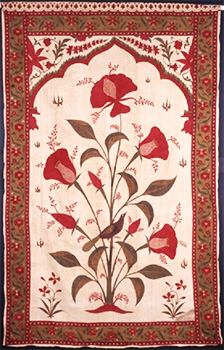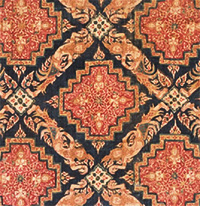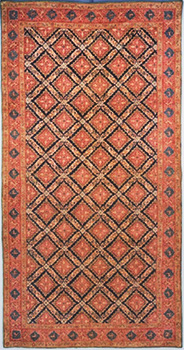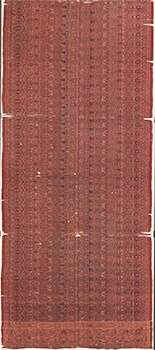
(1) Printed cloth, India
17th~18th century ; 221.0 cm × 135.5 cmCollection : Osaka City Museum of Modern Art, Planning Office

(2) Printed cloth, India, for the Thai market
18th century ; 220.0 cm × 119.0 cmCollection :Osaka City Museum of Modern Art, Planning Office
Enlarged view


Printed clothwith elaborate patterns produced in India for the Kingdom of Siam (the present-day Kingdom of Thailand) is commonly known as “Siam sarasa.” In response to the request of Siam, a Buddhist country, this work itemshowshas a wide variety of Buddhist motifs, such as images of the Buddha Garuda, and dragons. It was probably used as a wall ornament or rug.
(3)Weft ikat with supplementary weft weaving,Indonesia
17th~19th century;0 cm × 94.0 cmCollection: Osaka City Museum of Modern Art, Planning Office

Ikat is a dyeing and weaving technique in which warp and/or weft yarn is dyed prior to weaving, in a way so that a certain pattern appears as the cloth is woven. This work is weft ikat, which uses weft-dyed yarn,thought to have been produced in the 19th century in the central or eastern part of Java. Weft ikat cloth were used for loincloths worn in the court of Java from the 19th century to the early 20th century, but they were gradually replaced by batik, wax-resist dyed cloths which attained more popularity in Java. This work is now a precious example, as production of elaborately worked silk weft ikat of such a high quality declined by the early 20th century.
(4)Batik with gold print, Indonesia
20th century; 176.0 cm × 46.5 cmCollection:Osaka City Museum of Modern Art, Planning Office

The base cloth of this work is an indigo-dyed batik with geometric patterns, made in the northern coastal area of Java in Indonesia, onto which gold foil was applied so as to create a pattern indigenous to Bali. It is likely that this work was used in Bali as an ornament to decorate a temple or altar during a ritual.

The upper arch represents a mihrab(a prayer niche), which symbolizes the place where the Prophet Muhammad spoke of the revelations he heard from God. This item is thought to have been produced in India during the Mughal dynasty, possibly for export to the Middle East. It depicts a tree of life as well as a bird and flowers, created using both hand drawing and woodblock printing techniques. This item first came into the possession of Shingu Haruzo, an employee of Toyo Cotton Co. who was assigned to India, sometime between the Taisho period and the prewar days of the Showa period. Reportedly, Yamamoto Hatsujiro, through his collaborator, Yamao Kunmei, purchased many items from Shingu Haruzo around 1939 and added them to histextile collection.